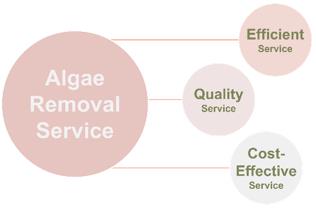Algae Removal Service
Nitrogen and phosphorus contamination from fertilizers or other nutrients can lead to excessive algal growth, which can form algal blooms and affect the entire ecosystem.
As a pioneer in algae research, Lifeasible offers professional, effective, and environmentally friendly algae removal services for our clients.
Introduction to Algal Bloom
Algae are a large group of organisms, including organisms with widely varying sizes, growth rates, and nutrient requirements. Algal blooms may result when specific nutrients, such as nitrogen, phosphorus, iron, vitamins, or amino acids, are introduced into the aquatic ecosystem. Several characteristic values are quantified to determine algal blooms, such as measurements of new algal biomass, concentrations of photosynthetic pigments, quantification of the negative effects of blooms, or relative concentrations of algae compared to other microbial communities.
Effect of Algal Bloom
Algal blooms reduce water clarity and discolor the water due to the presence of photosynthetic pigments in the algae. It also causes bacterial overgrowth and fermentation in the aquatic system after a large number of algae have died. Notable, harmful algal blooms (HAB), caused by harmful algal, can lead to oxygen depletion and massive fish kills. In addition, Microcystis aeruginosa can produce poisonous toxins, and Chaetoceros convolutus can damage fish gills.
Types of Algal Blooms
Freshwater algal blooms
Freshwater algal blooms are the result of excess nutrients, especially some phosphates from fertilizers and household cleaning products. Naturally, in stratified lakes with abundant sunlight, the change of seasons may release large amounts of bioavailable phosphorus, which can trigger algal blooms.
Marine algal blooms
Storms stir up the ocean during the winter, adding nutrients to sunlit waters near the surface, which can cause algal blooms. Marine algal blooms usually persist into late spring and early summer until nutrient levels drop.
Harmful algal blooms
HABs are algal blooms that adversely affect other organisms by producing natural toxins, causing mechanical damage to other organisms, or in other ways. The diversity of these HABs makes them more difficult to manage and poses many problems, especially for threatened coastal areas. HABs are often associated with large-scale marine mortality events, with negative economic and health impacts. HABs have been shown to be harmful to humans. Humans may be exposed to toxic algae through direct consumption of seafood containing toxins, swimming, or other activities in the water, and breathing tiny droplets of air containing toxins.
Our Services
Because algae have a significant impact on both aquatic ecosystems and human health, Lifeasible has a professional team to support our algae removal services.
Water Replacement
Physical or mechanical methods cannot be used to remove aquatic algae. A possible approach is to remove algae and invasive weeds quickly and permanently without using any chemicals. However, for large ponds and lakes, millions of gallons of water need to be replaced.
Non-Toxic Dyes
Non-toxic dyes are often used to control algae growth because they can reduce the amount of sunlight penetration. There are also common and safe herbicides such as copper complexes, sodium carbonate peroxide hydrate, and Alkylamine salts of Endothall that can also be used for algal bloom removal.
Why Choose Us
With years of algae-related research experience, Lifeasible is capable to provide professional algae removal services for our clients worldwide. Please contact us for more information.

Our services are for research use only and not for any clinical use.